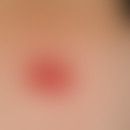Synonym(s)
DefinitionThis section has been translated automatically.
Candida glabrata is a haploid yeast of the genus Candida, formerly known as Torulopsis glabrata. The Candida species forms slightly curved, cream-coloured, smooth, dull colonies in culture. Other characteristics: Blastospores: rice grain-like, round to oval; size: 2um/4um x 4um/6um. Pseudomycel: none; Chlamydospores: none
Occurrence/EpidemiologyThis section has been translated automatically.
C. glabrata occurs ubiquitously and is a contaminant germ of e.g. fruit juices. In the past, C. glabrata was considered a primarily non-pathogenic yeast fungus. With the increasing number of immunosuppressed persons (AIDS and tumour patients under chemotherapy), it has been shown that C. glabrata is an opportunistic cause of infections of the urogenital tract, the gastrointestinal tract and the respiratory tract (vaginal mycosis, cystitis, oral candidiasis, intestinal candidosis). In these opportunistic systemic mycoses, weakened organisms are at risk of developing invasive candidoses with septic sequelae.
Complication(s)This section has been translated automatically.
A potential virulence factor of C. glabrata is the expression of adhesins encoded by the corresponding "epithelial cell adhesin genes". These genes are activated by signals from the environment. The expression of these adhesins enables yeasts to form "biofilms" e.g. on medical devices (urine catheters, dental equipment). This not only concerns C. glabrata but also Candida albicans, Candida tropicalis, and Candida parapsilosis.
Another complicating virulence factor of C. glabrata (and increasingly of Candida albicans) is the development of resistance to azoles. Azole antifungals, including fluconazole and ketoconazole, are ineffective against C. glabrata in 15-20 % of cases. Alternatives are the triazoles voriconazole (1.day 400mg, 2.+3. day 200mg, total 3 days) and posaconazole (1.day 200mg,2.-14.day 100mg, total 14 days). Furthermore, C. glabrata is sensitive to polyene drugs such as Amphotericin B and Nystatin. A variable sensitivity exists for flucytosine and caspofungin.
LiteratureThis section has been translated automatically.
- Cavalheiro M et al (2018) Candida Biofilms: Threats, Challenges, andPromising Strategies. Front Med (Lausanne)5:28.
- Colombo AL et al. (2017) Emerging multidrug-resistant Candida species. Curr Opin Infect Dis 30:528-538.
- Fan Y et al (2017) Isolated Cutaneous Granuloma Caused by Candida glabrata: A Rare Case Report and Literature Review. Mycopathologia doi: 10,1007/s11046-017-0228-3.
- Mushi MF et al (2017) Oral candidiasis among African human immunodeficiency virus-infected individuals: 10 years of systematic review and meta-analysis from sub-Saharan Africa. J Oral microbiol 9:1317579.
- Rodrigues CF et al (2017) Candida glabrata Biofilms: How Far Have We Come? J Fungi (Basel) pii: E11. doi: 10.3390/jof3010011.
Outgoing links (9)
Amphotericin b; Candida albicans; Caspofungin; Fluconazole; Flucytosine; Ketoconazole; Nystatin; Posaconazole; Voriconazole;Disclaimer
Please ask your physician for a reliable diagnosis. This website is only meant as a reference.



